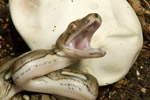
Green basilisk (Basiliscus plumifrons) in Costa Rica. Photo by: Rhett A. Butler.
As of this year, scientists have named and described over 10,000 reptiles, marking a new milestone in cataloging one of the most diverse vertebrate groups. Last week, the Reptile Database, an online catalog of all the world’s living reptiles, announced it had passed 10,000 species.
“Officially, we have logged 10,038 reptile species into the database, which is up from 9,952 that was reported in April,” said Peter Uetz, the founder and editor of the Reptile Database.
Reptiles include the world’s turtles, crocodilians, snakes, lizards, and a less commonly-known, ancient group from New Zealand known as the tuataras. The latter includes only two species. Reptiles originally evolved over 300 million years ago.
 Cyrtodactylus vilaphongi: the world’s 10,000th reptile. Photo by: Truong Nguyen. |
The new milestone is important because it means reptiles are as diverse as birds, which are generally considered to include around 10,000 species. Uetz predicts that reptiles will soon surpass birds given the rate of recent discoveries, making it the second-largest vertebrate group after fish which contains over 32,000 species.
Globally, there are around 5,500 mammal species and 6,400 amphibians currently.
But despite being among the most diverse vertebrate groups, reptiles are largely unrepresented by the IUCN Red List, which determines whether or not a species is endangered. Approximately all mammals and birds have been evaluated by the IUCN, and over 90 percent of amphibians have been evaluated. In contrast, only 43 percent of reptiles have been evaluated (the number is even worse for fish sitting at 35 percent).
“Hopefully, the new status as a five-digit species animal group brings more support, funding and awareness for the bewildering diversity reptiles continue to reveal,” said Uetz.
The 10,000th reptile added into the database was a new gecko described in early July in ZooTaxa. Discovered in the karst forests of Laos, the gecko is named Cyrtodactylus vilaphongi.
Related articles
No longer ‘deaf as a stump’: researchers find turtles chirp, click, meow, cluck

(07/25/2014) Turtles comprise one of the oldest living groups of reptiles, with hundreds of species found throughout the world. Many have been well-researched, and scientists know very specific things about their various evolutionary histories, metabolic rates, and the ways in which their sexes are determined. But there was one very obvious thing that has been largely left unknown by science until very recently. Turtles can make sounds.
Please, don’t hate us: celebrating World Snake Day!

(07/16/2014) Okay, so some snakes are so venomous they can kill you in 30 minutes (the inland taipan). And, yes, the fact that they don’t have legs is a little creepy to many people. And, admittedly, some scientists have even suggested that humans may have an inborn genetic terror of snakes.
‘Hope springs eternal’: the anniversary of the death of Lonesome George

(06/24/2014) Today marks the two-year anniversary of the death of Lonesome George, the world’s last Pinta Island tortoise. The occasion calls attention to the declines of many turtle and tortoise species, which together form one of the most swiftly disappearing groups of animals on the planet.
Researchers discover new species of wolf snake in Cambodia, name it after an Australian zoo
(06/16/2014) A new species of wolf snake has been discovered in the Cardamom Mountains of southeast Cambodia.
Emerald-faced reptile discovered in Ecuador
(05/23/2014) Researchers have discovered a colorful lizard species in the cloud forests of northwestern Ecuador.